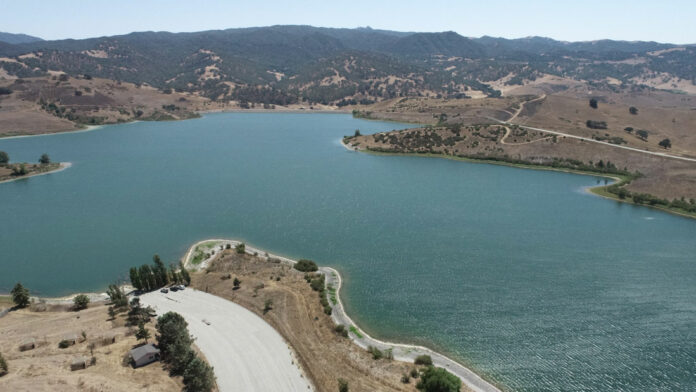Winter storms brought significant snowfall to the Sierra Nevada and other California mountains in December. Snowpack is critical for the state’s spring water outlook because when the snow melts it runs downhill into streams that fill reservoirs that hold about 30% of the state’s water supply. This water is moved throughout the state via the State Water Project and the Central Valley Project (CVP).
On Dec. 30, the Sierra snowpack was estimated to be about 160% of average for that date. At the beginning of February, the snowpack was down to 92% of the historical average for this time period, according to state data. The snowpack is starting to melt because of unseasonably warm temperatures and dry weather.
Our water year begins Oct. 1 as the state picks up most of its rainfall during the months of November through April, better known as our “rainy season.” Some long-range forecasts show it will be dry for the remainder of our rainy season this year.
Warmer temperatures are leading to higher evaporation rates. This affects the amount of water running downhill into state and federal reservoirs and what water will be allocated to our county later this year.
San Benito County Water District (SBCWD) is a federal contractor with the United States Bureau of Reclamation (USBR) and imports water from the CVP. Our county’s share of this water is stored in San Luis reservoir before being pumped through the Pacheco Pass to our county.
The imported surface water helps keep our local groundwater basin stay in balance, is used to improve our drinking water quality and assists in producing high-quality, specialty crops.
Groundwater is used when surface water supplies are reduced due to drought or environmental needs in the Delta, and groundwater is replenished when surface water supplies are available. Groundwater quality in our basin can be described as naturally hard (typical of similar Coast Range basins) and less than ideal water quality for drinking and agricultural purposes. While the groundwater is considered hard, it has been and is being used for a range of beneficial uses with reasonable accommodation by users.
Over the last decade, the average allocations of our county’s imported, surface water deliveries have been trending downward. On average, SBCWD has received about 30% of their contracted amount from the federal government (CVP) on surface water deliveries.
To help offset this deficit, SBCWD worked with the City of Hollister to construct a water recycling facility at the city’s Reclamation Plant. This project is highly efficient because the water that is imported is first used as drinking water for the urban areas. When the imported water leaves residents’ homes as wastewater, it makes its way to the reclamation plant where it is treated and used for agricultural and landscape accounts.
The SBCWD also buys water on the Spot Market to help offset smaller allocations of surface water deliveries from the CVP. There are contracts and agreements with other agencies to acquire this water. However, this water can be quite costly.
The SBCWD has also stored water during wet years with higher allocations at a groundwater bank in the Central Valley. But this too has drawbacks. Storage has costs and a considerable amount of water is lost due to evaporation and/or seepage when water is exchanged.
The district manager is always looking ahead and planning for the next water year. Having surface water in storage is important due to the variability of CVP water due to drought and environmental concerns.
The SBCWD “carries over” water when it can. Carryover water is water supply that a district does not use in a prior water year that can be stored within CVP reservoirs. Each contractor has a certain amount of “carryover capacity” negotiated in the contract that allows it to store up to that amount in CVP reservoirs, particularly in San Luis. Generally, this “carryover water” is subject to losses if the USBR needs the capacity.
Many districts purchased carryover water in the past few years to make up for unreliable or in some years, non-existent CVP supplies. Last year, for instance, the SBCWD only received 2,000 acre-feet of water from the CVP but was able to deliver 12,000 acre-feet of water to customers due to carryover water.
Other ideas are being explored on how to store water during wet years that can be used in dry years. One idea is for an Aquifer Storage and Recovery (ASR) project. Aquifer Storage and Recovery is a manmade process or natural process enhanced by humans that conveys water underground. The process replenishes groundwater stored in aquifers for beneficial purposes. ASR is used to store water, which is later recovered for use.
Projects for ASR are increasing in number nationwide, especially in areas with potential for water shortages. ASR projects are frequently found in areas of the United States that have high population density, proximity to intensive agriculture, dependence and increasing demand on groundwater for drinking water and agriculture and limited ground or surface water availability.
The objective of ASR is to replenish water in an aquifer. The stored water may be recovered from the same well used for injection or from nearby injection or recovery wells.
Water managers, state officials and elected officials are all working on diversifying, improving and bolstering our water supply. However, we still need every person to use water efficiently and conserve whenever possible since water is a finite resource. Not just when we are in drought, but always.
The first thing to do is to call the Water Resources Association of San Benito County (WRASBC) for a free leak check and irrigation system evaluation and assessment. The WRASBC represents the City of Hollister, City of San Juan Bautista, Sunnyslope County Water District and the San Benito County Water District for all their water conservation and water resource protection programs.
The WRASBC can be reached at: 831.637.4378 or check out their website at www.wrasbc.org for a list of programs, services and water saving ideas.
Shawn O. Novack is Water Conservation Programs Manager for the Water Resources Association of San Benito County, and the San Benito County Water District.








